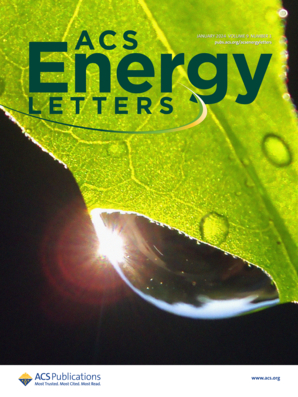3D Chiral Metal Halide Semiconductors
IF 19.3
1区 材料科学
Q1 CHEMISTRY, PHYSICAL
引用次数: 0
Abstract
Chiral metal halides are promising materials for nonlinear optics and spin-selective devices. Typically, chirality is introduced via large chiral organic cations, leading to low-dimensional structures and limitations in charge transport. Here, we design a family of chiral metal halides based on the relatively small ditopic R/S-3-aminoquinuclidine (3-AQ) cation, forming an (R/S-3AQ)Pb2Br6 structure closely related to the 3D corner-sharing octahedral network of perovskites. The resulting material exhibits a direct bandgap, isotropic band structure, and fully 3D photoexcitation. Circular dichroism confirms a chiral anisotropy factor consistent with theoretical predictions. Moreover, the material displays a Rashba effect in the conduction band, which is attributed to spin–orbit coupling and the lack of inversion symmetry. Offering rich chemical tunability and efficient 3D charge transport, this new class of chiral semiconductors provides a promising platform for advancing nonlinear optoelectronic and spintronic devices.

3D手性金属卤化物半导体
手性金属卤化物是非线性光学和自旋选择器件中很有前途的材料。通常,手性是通过大的手性有机阳离子引入的,导致低维结构和电荷输运的限制。在此,我们基于相对较小的双位R/ s -3-氨基喹啉(3-AQ)阳离子设计了一个手性金属卤化物家族,形成了与钙钛矿三维共角八面体网络密切相关的(R/S-3AQ)Pb2Br6结构。所得材料具有直接带隙、各向同性带结构和全三维光激发。圆二色性证实了与理论预测相一致的手性各向异性因素。此外,材料在导带中表现出Rashba效应,这是由于自旋-轨道耦合和反演对称性的缺乏。这种新型手性半导体具有丰富的化学可调性和高效的3D电荷传输,为推进非线性光电和自旋电子器件提供了一个有前途的平台。
本文章由计算机程序翻译,如有差异,请以英文原文为准。
求助全文
约1分钟内获得全文
求助全文
来源期刊

ACS Energy Letters
Energy-Renewable Energy, Sustainability and the Environment
CiteScore
31.20
自引率
5.00%
发文量
469
审稿时长
1 months
期刊介绍:
ACS Energy Letters is a monthly journal that publishes papers reporting new scientific advances in energy research. The journal focuses on topics that are of interest to scientists working in the fundamental and applied sciences. Rapid publication is a central criterion for acceptance, and the journal is known for its quick publication times, with an average of 4-6 weeks from submission to web publication in As Soon As Publishable format.
ACS Energy Letters is ranked as the number one journal in the Web of Science Electrochemistry category. It also ranks within the top 10 journals for Physical Chemistry, Energy & Fuels, and Nanoscience & Nanotechnology.
The journal offers several types of articles, including Letters, Energy Express, Perspectives, Reviews, Editorials, Viewpoints and Energy Focus. Additionally, authors have the option to submit videos that summarize or support the information presented in a Perspective or Review article, which can be highlighted on the journal's website. ACS Energy Letters is abstracted and indexed in Chemical Abstracts Service/SciFinder, EBSCO-summon, PubMed, Web of Science, Scopus and Portico.
 求助内容:
求助内容: 应助结果提醒方式:
应助结果提醒方式:


